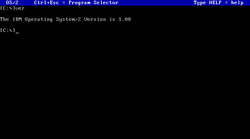Build list legend
Non-existent page
| Version of OS/2 | |
 | |
 | |
| Version | 1.0 |
|---|---|
| Codename | CP/DOS ADOS |
| Preliminary name | DOS 4.0[1] DOS 5.0 |
| Architecture | Intel 286 |
| Latest build | |
| Release date | 1987-12 |
| Support end | |
OS/2 1.0 is the first version of OS/2 to be released. It was originally meant to be DOS 5.0, and in fact, some early documentation refers to it as "DOS 5.0" rather than "OS/2". There is no GUI in this release.
OS/2 began development in January 1983 as a real-mode, preemptively multitasked fork of MS-DOS 2.0, which was eventually released as Multitasking MS-DOS 4. Shortly after the Joint Development Agreement from IBM and Microsoft in August 1985, DOS 4.0 was split into two projects – "DOS 5.0" and versions of DOS 4.0 for the few OEMs that licensed the product; DOS 4.0 was ported to protected mode and many additional features were added – the "DOS 5.0" project went by many names during this time, such as 286DOS, Big DOS, ADOS, and CP/DOS (mostly at IBM). On 2 April 1987, the newly christened OS/2 1.0 was announced, with an initial release date of the first quarter of 1988, followed by OS/2 1.1 within the end of that year.[2] The development of the original OS/2 release was suited to take advantages of the IBM's new PS/2 line of computers, alongside IBM AT-compatible systems. Throughout development, IBM and Microsoft were split on the marketing of OS/2; IBM primarily sold OS/2 to users of IBM systems, while Microsoft focused with working on OEMs to provide a variety of support for non-IBM AT-compatible systems.
Prior to the release of OS/2 1.0, Microsoft would start its OS/2 development program and ship its own SDK releases of OS/2 at the price of $3000. By May 1987, Microsoft would ship with the OS/2 SDK 1.00, which provided a pre-release version of Microsoft OS/2 and beta compiling programs for software developers.[3] OS/2 SDK 1.01 would ship in August 1987, adding the Program Selector interface with the original pre-release build that shipped with the SDK 1.00 release. By the time OS/2 1.0 released, the SDK 1.02 release had the final build, but still with incomplete compiling programs.
OS/2 1.0 would ship earlier than its announced date – released in December 1987, OS/2 1.0 was marketed to succeed DOS and as a transitional OS for DOS users. OS/2 1.0 enabledlx users to dual boot from another DOS release with OS/2. Compared to MS-DOS and IBM's PC-DOS, OS/2 1.0 provided a new API library that handled hardware instructions directly on the system, allowing programs to utilize the OS/2 API instead of relying on BIOS or hardware calls. OS/2 was designed to run in protected mode, although IBM's release would switch to real mode during the setup. OS/2 1.0 also utilized advantages based on the 286 processor, including the segmented memory model and multithreading. However, OS/2 1.0 didn't utilize any advantages of the 386 processor, including handling 32-bit applications. The operating system received mixed reception for expanding upon processor capabilities but was lashed for poor compatibility with DOS applications, primarily in part of the lack of virtual 8086 mode support bought by the 386 processor. OS/2 1.0 sold poorly to the user market but decently well to the corporate market. The aforementioned OS/2 1.1 would release in 1988, providing a proper GUI interface for users of OS/2 1.0.
Build list legend